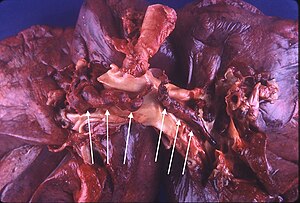Pulmonary thrombectomy

A pulmonary thrombectomy is an emergency surgical procedure used to remove blood clots from the pulmonary arteries.
Mechanical thrombectomies can be surgical (surgical thrombectomy) or percutaneous (percutaneous thrombectomy).[1]
Surgical thrombectomies were once popular but were abandoned because of poor long-term outcomes. Recently, in selected patients, they have gone through a resurgence with the revision of the surgical technique.[2]
Relation to PTE
Pulmonary thrombectomies and pulmonary thromboendarterectomies (PTEs) are both operations that remove thrombus. Aside from this similarity they differ in many ways.
- PTEs are done on a nonemergency basis while pulmonary thrombectomies are typically done as an emergency procedure.
- PTEs typically are done using hypothermia and full cardiac arrest.
- PTEs are done for chronic pulmonary embolism, thrombectomies for severe acute pulmonary embolism.
- PTEs are generally considered a very effective treatment, surgical thrombectomies are an area of some controversy and their effectiveness a matter of some debate in the medical community.
See also
References
- ^ Casazza F, Roncon L, Greco F (Oct 2005). "Pulmonary embolism: treatment of the acute episode". Ital Heart J. 6 (10): 818–23. PMID 16270473.
- ^ Augustinos P, Ouriel K (2004). "Invasive approaches to treatment of venous thromboembolism". Circulation. 110 (9 Suppl 1): I27–34. doi:10.1161/01.CIR.0000140900.64198.f4. PMID 15339878.
External links
 Media related to Pulmonary thrombectomy at Wikimedia Commons
Media related to Pulmonary thrombectomy at Wikimedia Commons
